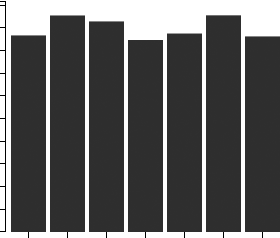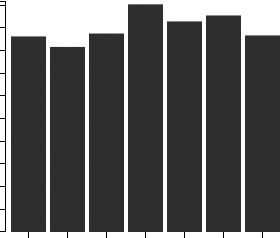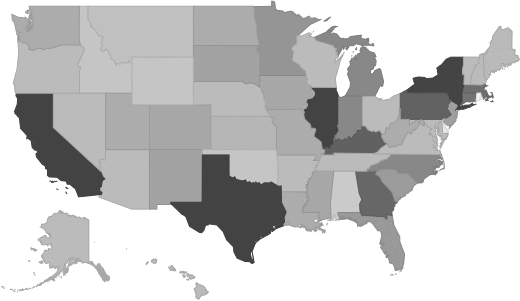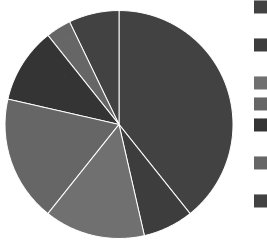Nonmetallic Mineral Mining & Quarrying Industry - Market Research Report
Industry Overview
This industry group comprises establishments primarily engaged in developing mine sites, or in mining or quarrying nonmetallic minerals (except fuels). Also included are certain well and brine operations, and preparation plants primarily engaged in beneficiating (e.g., crushing, grinding, washing, and concentrating) nonmetallic minerals. Beneficiation is the process whereby the extracted material is reduced to particles which can be separated into mineral and waste, the former suitable for further processing or direct use. The operations that take place in beneficiation are primarily mechanical, such as grinding, washing, magnetic separation, and centrifugal separation. In contrast, manufacturing operations primarily use chemical and electrochemical processes, such as electrolysis and distillation. However, some treatments, such as heat treatments, take place in both the beneficiation and the manufacturing (i.e., smelting/refining) stages. The range of preparation activities varies by mineral and the purity of any given ore deposit. While some minerals, such as petroleum and natural gas, require little or no preparation, others are washed and screened, while yet others, such as gold and silver, can be transformed into bullion before leaving the mine site.
Source: U.S. Census BureauMarket Size and Industry Forecast
This research report analyzes the market size and trends in the Nonmetallic Mineral Mining and Quarrying industry. It shows overall market size from 2020 to the present, and predicts industry growth through 2030. Revenues data include both public and private companies.
| Historical | Forecasted |
|---|
| 2020 | 2021 | 2022 | 2023 | 2024 | 2025 | 2026 | 2027 | 2028 | 2029 | 2030 |
|---|
| Market Size (Total Revenue) | Included in Report |
| % Growth Rate |
| Number of Companies |
| Total Employees |
| Average Revenue per Company |
| Average Employees per Company |
Source: U.S. government financial dataIndustry Revenue ($ Billions)

Industry Forecast ($ Billions)

Advanced econometric models forecast five years of industry growth based on short- and long-term trend analysis. Market size includes revenue generated from all products and services sold within the industry.
Geographic Breakdown by U.S. State
Market size by state reveals local opportunity through the number of companies located in the region. Each state's growth rate is affected by regional economic conditions. Data by state can be used to pinpoint profitable and nonprofitable locations for Nonmetallic Mineral Mining & Quarrying companies in the United States.
Nonmetallic Mineral Mining & Quarrying Revenue by State

Distribution by Company Size
| Company Size | All Industries | Nonmetallic Mineral Mining & Quarrying |
|---|
| Small Business (< 5 Employees) | Included |
| Small Business (5 - 20) |
| Midsized Business (20 - 100) |
| Large Business (100 - 500) |
| Enterprise (> 500) |
Nonmetallic Mineral Mining & Quarrying Industry Income Statement (Average Financial Metrics)
Financial statement analysis determines averages for the following industry forces:
- Cost of goods sold
- Compensation of officers
- Salaries and wages
- Employee benefit programs
- Rent paid
- Advertising and marketing budgets
The report includes a traditional income statement from an "average" company (both public and private companies are included).
| Industry Average | Percent of Sales |
|---|
| Total Revenue | Included |
| Operating Revenue |
| Cost of Goods Sold (COGS) |
| Gross Profit |
| Operating Expenses |
| Operating Income |
| Non-Operating Income |
| Earnings Before Interest and Taxes (EBIT) |
| Interest Expense |
| Earnings Before Taxes |
| Income Tax |
| Net Profit |
Average Income Statement

Cost of Goods Sold
Salaries, Wages, and Benefits
Rent
Advertising
Depreciation and Amortization
Officer Compensation
Net Income
Financial Ratio Analysis
Financial ratios allow a company's performance to be compared against that of its peers.
| Financial Ratio | Industry Average |
|---|
| Profitability Ratios | Included |
| Profit Margin |
| ROE |
| ROA |
| Liquidity Ratios |
| Current Ratio |
| Quick Ratio |
| Activity Ratios |
| Average Collection Period |
| Asset Turnover Ratio |
| Receivables Turnover Ratio |
| Inventory Conversion Ratio |
Salary information for employees working in the Nonmetallic Mineral Mining & Quarrying industry.
| Title | Percent of Workforce | Bottom Quartile | Average (Median) Salary | Upper Quartile |
|---|
| Management Occupations | 5% | Included |
| Chief Executives | 0% |
| General and Operations Managers | 3% |
| Office and Administrative Support Occupations | 10% |
| Construction and Extraction Occupations | 32% |
| Construction Trades Workers | 16% |
| Construction Equipment Operators | 12% |
| Operating Engineers and Other Construction Equipment Operators | 12% |
| Extraction Workers | 13% |
| Mining Machine Operators | 7% |
| Installation, Maintenance, and Repair Occupations | 10% |
| Other Installation, Maintenance, and Repair Occupations | 5% |
| Production Occupations | 13% |
| Other Production Occupations | 10% |
| Transportation and Material Moving Occupations | 25% |
| Motor Vehicle Operators | 10% |
| Driver/Sales Workers and Truck Drivers | 10% |
| Heavy and Tractor-Trailer Truck Drivers | 10% |
| Material Moving Workers | 14% |
| Dredge, Excavating, and Loading Machine Operators | 9% |
| Excavating and Loading Machine and Dragline Operators | 8% |
Government Contracts
The federal government spent an annual total of
$56,058,573 on the nonmetallic mineral mining & quarrying industry. It has awarded 1,636 contracts to 446 companies, with an average value of $125,692 per company.
Top Companies in Nonmetallic Mineral Mining & Quarrying and Adjacent Industries
| Company | Address | Revenue
($ Millions) |
|---|
Included |



